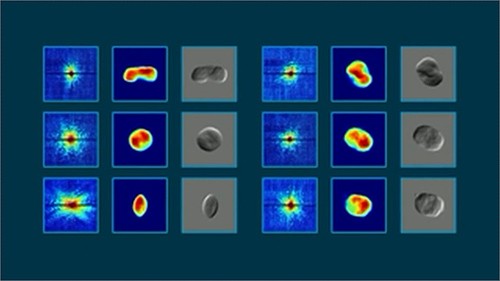Scientists Capture Live Bacteria Portraits for the First Time
| Marco Foronda | | Feb 13, 2015 05:15 AM EST |
(Photo : SLAC National Accelerator Laboratory) X-ray portraits of living cyanobacteria using SLAC's Linac Coherent Light Source.
For the first time in history, researchers were able to observe a chemical bond being born.
Using an X-ray laser at the Department of Energy's SLAC National Accelerator Laboratory, scientists caught their first glimpse of the transition state in which two atoms begin to form a weak bond in the first steps of transforming into a molecule.
Like Us on Facebook
The findings could lead to X-ray exploration of the molecular machinery at work in viral infections, cell division, photosynthesis and other processes.
"This is the very core of all chemistry. It's what we consider a Holy Grail, because it controls chemical reactivity. But because so few molecules inhabit this transition state at any given moment, no one thought we'd ever be able to see it," said Professor Anders Nilsson at the SLAC/Stanford SUNCAT Center for Interface Science and Catalysis and study lead author.
The experiment focused on cyanobacteria, or blue-green algae, an abundant form of bacteria that transformed the Earth's atmosphere 2.5 billion years ago by releasing breathable oxygen, making possible new forms of life that are dominant today.
Cyanobacteria play a key role in the planet's oxygen, carbon and nitrogen cycles.
Researchers sprayed living cyanobacteria in a thin stream of humid gas through a gun-like device. The cyanobacteria were alive and intact when they flew into the ultrabright, rapid-fire LCLS X-ray pulses, producing diffraction patterns recorded by detectors.
The X-ray laser pulses from SLAC's Linac Coherent Light Source (LCLS) allowed the team to observe this process by detecting changes in the arrangement of the atoms' electrons that occurred in quadrillionths of a second.
They were surprised to observe many of the reactants entered a transition state, but only a small number formed stable carbon dioxide without breaking apart.
The team is now working to measure the transition state in other catalytic reactions that can generate commercially-valuable chemicals.
The technique can capture about 100 images per second, amassing many millions of high-resolution X-ray images in a single day, researchers noted.
Details of the study were published in the journal, Nature Communications.
Tagslive bacteria, Cyanobacteria, viral infections, cell division, Photosynthesis, bacteria, live bacteria image, x-ray laser bacteria
©2015 Chinatopix All rights reserved. Do not reproduce without permission
EDITOR'S PICKS
-

Did the Trump administration just announce plans for a trade war with ‘hostile’ China and Russia?
-

US Senate passes Taiwan travel bill slammed by China
-

As Yan Sihong’s family grieves, here are other Chinese students who went missing abroad. Some have never been found
-

Beijing blasts Western critics who ‘smear China’ with the term sharp power
-

China Envoy Seeks to Defuse Tensions With U.S. as a Trade War Brews
-

Singapore's Deputy PM Provides Bitcoin Vote of Confidence Amid China's Blanket Bans
-

China warns investors over risks in overseas virtual currency trading
-

Chinese government most trustworthy: survey
-

Kashima Antlers On Course For Back-To-Back Titles
MOST POPULAR
LATEST NEWS
Zhou Yongkang: China's Former Security Chief Sentenced to Life in Prison

China's former Chief of the Ministry of Public Security, Zhou Yongkang, has been given a life sentence after he was found guilty of abusing his office, bribery and deliberately ... Full Article
TRENDING STORY

China Pork Prices Expected to Stabilize As The Supplies Recover

Elephone P9000 Smartphone is now on Sale on Amazon India

There's a Big Chance Cliffhangers Won't Still Be Resolved When Grey's Anatomy Season 13 Returns

Supreme Court Ruled on Samsung vs Apple Dispute for Patent Infringement

Microsoft Surface Pro 5 Rumors and Release Date: What is the Latest?










